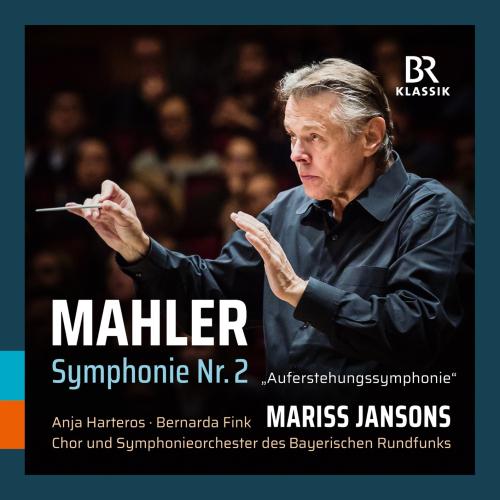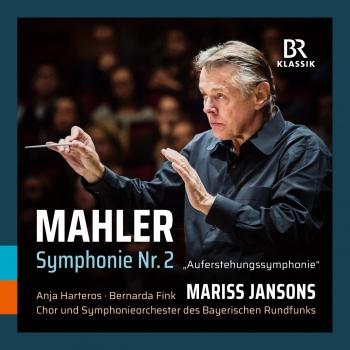
Mahler: Symphony No. 2 in C Minor "Resurrection" (Live) Anja Harteros, Bernarda Fink, Symphonieorchester des Bayerischen Rundfunks & Mariss Jansons
Album info
Album-Release:
2018
HRA-Release:
05.10.2018
Label: BR-Klassik
Genre: Classical
Subgenre: Vocal
Artist: Anja Harteros, Bernarda Fink, Symphonieorchester des Bayerischen Rundfunks & Mariss Jansons
Album including Album cover Booklet (PDF)
- Gustav Mahler (1860 - 1911): Symphony No. 2 in C Minor "Resurrection":
- 1 Symphony No. 2 in C Minor "Resurrection": I. Allegro maestoso (Live) 21:26
- 2 Symphony No. 2 in C Minor "Resurrection": II. Andante moderato (Live) 09:48
- 3 Symphony No. 2 in C Minor "Resurrection": III. In ruhig fließender Bewegung (Live) 11:17
- 4 Symphony No. 2 in C Minor "Resurrection": IV. Urlicht (Live) 05:00
- 5 Symphony No. 2 in C Minor "Resurrection": V. Finale. Im Tempo des Scherzo (Live) 33:23
Info for Mahler: Symphony No. 2 in C Minor "Resurrection" (Live)
Gustav Mahler's Second Symphony, also referred to as the "Resurrection Symphony", is a complete expression of Mahler’s existential struggle; both its form and its overpowering sound make this utterly clear. This live recording from 20011 is performed by the Chor and Symphonieorchester des Bayerischen Rundfunks under its chief conductor Mariss Jansons with the two singers Anja Harteros and Bernarda Fink.
Gustav Mahler wanted his Second Symphony to exceed any known format – and he also wanted it to tackle the key questions of existence: “Why have you lived?Why have you suffered?Is everything just one enormous, terrible joke?We have to solve these questions in some way if we want to carry on living,” said the composer.Similar questions preoccupied him throughout his life, and with a special intensity during his time as an opera conductor in Hamburg. The Second Symphony, also referred to as the “Resurrection Symphony”, is a complete expression of Mahler’s existential struggle; both its form and its overpowering sound make this utterly clear.
The symphony took several years to compose – it was written between 1888 and 1894. In September 1888, the first movement – which at this point still bore the title “Totenfeier” (“Funeral Rite”) – was already complete. The second and third movements were not written until 1893 and Mahler only completed the entire work in 1894. The composer himself said that the notion of making the final movement a musical setting of the idea of resurrection occurred to him in 1894 during the funeral for the conductor Hans von Bülow, in the St. Michaelis Church in Hamburg. At that time he was working on songs from “Des Knaben Wunderhorn”, and re-used “The Fish Sermon of St Anthony of Padua” and “Urlicht” from that song cycle as vocal insertions in his symphony. Like most of Mahler’s symphonies, the work follows a “Per aspera ad astra” pattern (“Through paths lead to the stars”). Starting with a funeral march in the main theme of the opening movement – the passing of a life full of vigour, pain, blows of fate, and only a few brief and beautiful moments – the symphony concludes with a triumphant resurrection movement. This finale, based on Klopstock’s poem “Resurrection”, was Mahler’s trenchant summary of the entire masterpiece, and is in fact the longest symphonic movement in his entire oeuvre.
The premiere of the complete symphony took place on December 13, 1895 in Berlin under Mahler’s direction;previously (on March 4 of that year) he had already performed the first three movements.The premiere of the Second Symphony thus took place after that of the Third.The reactions were initially subdued, but today the work ranks as one of the most popular of Mahler’s symphonies.- The Munich concert event of May 2011 is now being released on BR-KLASSIK as a CD – it is a star-studded, outstanding interpretation of one of the most important compositions in the Late Romantic symphonic repertoire.
Anja Harteros, soprano
Bernarda Fink, alto
Chor des Bayerischen Rundfunks
Symphonieorchester des Bayerischen Rundfunks
Mariss Jansons, conductor
Anja Harteros
is today one of the world's most popular singers in her field and can be seen and heard performing on all the great opera and concert stages. Even during her studies at the Cologne College of Music with Professor Liselotte Hammes, her first engagements took her at the young age of 23 to the opera houses of Gelsenkirchen and Bonn.
After winning the Cardiff Singer of the World Competition in 1999, Anja Harteros was invited by the Bavarian State Opera to give her role debut as Agathe in Der Freischütz under the baton of Zubin Mehta.
Her international career then took off, with engagements at all the big opera houses, such as the New York Met, La Scala in Milan, the Royal Opera House Covent Garden London, the state opera houses of Munich, Vienna, Berlin, Hamburg and Dresden, and the opera houses in Florence, Amsterdam, Paris, Tokyo, Lyon, Berlin and San Diego, as well as appearances at the Edinburgh Festival and the Salzburg Festival.
She works with famous conductors such as Marco Armiliato, Ivor Bolton, Sylvain Cambreling, Jesus Lopez Cobos, James Conlon, Sir Eliot Gardiner, Mariss Jansons, James Levine, Fabio Luisi, Zubin Metha, Ingo Metzmacher, Riccardo Muti, Kent Nagano, Sir Roger Norrington, Antonio Pappano, and Christian Thielemann.
The singer was awarded the Munich Opera Festival Prize for her outstanding vocal and acting achievements during the 2004/2005 season at the Bavarian State Opera in Munich. Other awards include: Bayerische Kammersängerin 2007, Kölner Opernpreis 2010.
Her versatile repertory includes roles like Mimì in La Bohème, Violetta in La Traviata, Desdemona in Otello, Elisabetta in Don Carlos, Amelia in Simon Boccanegra, Alice Ford in Falstaff, Micaëla in Carmen, Fiordiligi in Così fan tutte, Contessa in Le nozze di Figaro, Donna Anna in Don Giovanni, Elettra in Idomeneo, Agathe in Der Freischütz, Eva in Die Meistersinger von Nürnberg, Elisabeth in Tannhäuser, Elsa in Lohengrin and the title roles in Alcina and Arabella.
Bernarda Fink
daughter of Slovenian parents, was born in Buenos Aires and received her vocal and musical education at the Instituto Superior de Arte del Teatro Colón where she performed frequently.
Bernarda Fink is one of the most sought-after singers in concerts and recitals. She has been acclaimed for her musical versatility and invited by the leading orchestras and conductors in Europe and America. Her repertoire ranges from ancient music up to music of the 20th century. She frequently appears with such well-known orchestras as the Vienna and Berlin Philharmonic Orchestras, Royal Concertgebouw Orchestra, Staatskapelle Berlin and Dresden, Bavarian Radio Symphony Orchestra, the Cleveland Orchestra, the Chicago Symphony Orchestra, as well as with the best-known Baroque orchestras under such famous conductors as Daniel Barenboim, Herbert Blomstedt, Semyon Bychkov, Riccardo Chailly, Sir John Eliot Gardiner, Valery Gergiev, Bernard Haitink, René Jacobs, Mariss Jansons, Riccardo Muti, Sir Roger Norrington, Trevor Pinnock, Georges Prêtre, Sir Simon Rattle and Franz Welser-Möst. She had a close artistic cooperation with Nikolaus Harnoncourt which is testified by numerous TV and CD recordings.
Bernarda Fink has appeared to widespread critical acclaim in Argentina and at the most important opera houses in Europe. Recent highlights were the roles of Cecilio/LUCIO SILLA led by Nikolaus Harnoncourt at the Theater an der Wien, Idamante/IDOMENEO in a production of Luc Bondy and Jesus Lopez Cobos at the Teatro Real in Madrid, and Irene/THEODORA under Ivor Bolton at the Salzburg Festival. She also sang Sesto/LA CLEMENZA DI TITO and Idamante in concert versions under the baton of René Jacobs, both of which were recorded and highly praised. In June 2017, Bernarda Fink made her debut in Debussy´s PELLÉAS ET MÉLISANDE at the Vienna State Opera.
Bernarda Fink regularly appears in recital at the Wiener Musikverein and Konzerthaus, Schubertiade Schwarzenberg, Berlin Philharmonie, Théâtre Royal de la Monnaie in Brussels, Edinburgh Festival, Carnegie and Alice Tully Hall in New York. Furthermore Bernarda Fink performed Dvořák and Janacek songs together with the Pavel Haas Quartett at London´s Wigmore Hall, at the Concertgebouw in Amsterdam, in Den Haag and in Madrid. In the 2015/2016 season, she gave recitals in Buenos Aires, Ljubljana and Zeist.
Highlights of the past seasons were, alongside numerous recitals, Pergolesi´s STABAT MATER in Rome, Mahler´s SYMPHONY No. 2 with Mariss Jansons in Copenhagen and with Jakub Hrůša in Bamberg, his SYMPHONY No. 3 in Katowice, a tour across South America with Camerata Salzburg as well as concerts at the Internationale Barocktage Stift Melk.
In addition to recitals in Cologne, Vienna, Madrid and Paris, concerts of the season 2018/2019 inlcude Dvořák´s BIBLICAL SONGS with Manfred Honeck in Prague and Dresden, SALVE REGINA by Porpora with Riccardo Muti in Vienna, Mahler´s SYMPHONY No. 2 with the Boston Symphony Orchestra and Andris Nelsons and with the Orchestre National des Pays de la Loire in Angers und Nantes, Mahler´s SYMPHONY No. 3 in Bamberg, Paris, Muscat and Ostrava as well as his LIED VON DER ERDE with the South Netherlands Philharmonic and Hans Graf in the Netherlands.
Bernarda Fink regularly holds master classes at the Wiener Meisterkurse, the Young Singers Project (YSP) in Salzburg, the Academy of the Festival in Aix-en-Provence, the Schubert-Institute in Baden (near Vienna), at the Aldeburgh Festival and the Fondation Royaumont. She was also on the jury of the International Song Competition of London Wigmore Hall, the Bach Wettbewerb Leipzig, BBC Cardiff Singers of the World, DAS LIED International Song Competition as well as the ARD Music Competition.
Bernarda Fink has made numerous highly acclaimed recordings. Her discography comprises more than 50 releases, ranging from Monteverdi and Rameau to Schubert and Bruckner and Schumann. Many of them have been awarded coveted prizes such as the Diapason d’Or or the Grammy. Bernarda Fink has a close collaboration with Harmonia Mundi. Recent recordings include Bach Cantatas with the Freiburger Barockorchester, and Lieder by Schumann with accompanist Anthony Spiri, Pergolesi’s STABAT MATER with the Akademie für Alte Musik Berlin and programs with Lieder by Slovenian as well as Argentinian composers together with her brother, the baritone Marcos Fink (Grammy nomination). In 2012, albums of Dvořák Lieder (together with Genia Kühmeier), and with Spanish Songs (de Falla, Granados, Rodrigo and others) again with Anthony Spiri at the piano, were released. Her latest album included Mahler Lieder accompanied by the Niederösterreichische Tonkünstlerorchestra and Andrés Orozco-Estrada and by the pianist Anthony Spiri.
In February 2006, Bernarda Fink was awarded the Austrian Honorary Medal for Art and Science by the Austrian Chancellor and in February 2013, together with her brother Marcos Fink, the most prestigious cultural award of Slovenia sponsored by the Prešeren-foundation for their recording Slovenija! and the related concerts. In September 2014 she received the title of Österreichische Kammersängerin.
Booklet for Mahler: Symphony No. 2 in C Minor "Resurrection" (Live)










